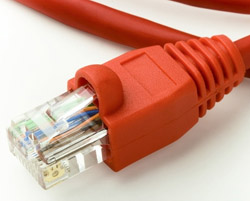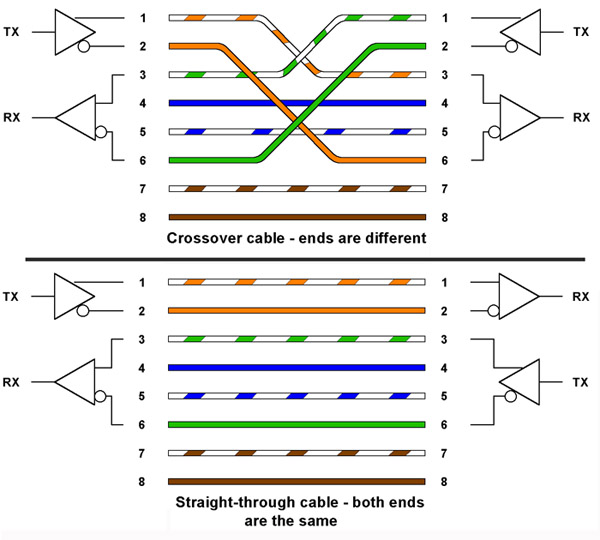
Industry associations have defined the T-568A and T-568B standards for Ethernet cables so that a Type A device, like a computer, connected to a Type B device, such as a hub, uses a simple straight-through cable.
When a Type A device is connected to another Type A device, or a Type B device is connected to another Type B device, a crossover cable, which swaps the transmit and receive pins, must be used.
Figure 1 (below) illustrates the difference between the straight-through and crossover configurations.
In a Type A to Type B connection, say a computer to a hub, the computer uses pins 1 and 2 to transmit data and pins 3 and 6 to receive data, whereas the hub receives data on pins 1 and 2 and transmits on pins 3 and 6.
In a connection between two Type A’s or two Type B’s, both want to use the same pair for transmission, so the pairs are swapped in the cable and both receivers now see a transmitter.
In either arrangement, the signal transmitted/received on pins 2 and 6 are inverted versions of the signals on pins 1 and 3, respectively.
Also, odd-numbered pins always contain a striped wire, and even-numbered pins always contain a solid wire. Pins 4, 5,7, and 8 are often not used, but they may be used to supply power to Ethernet devices. This configuration is called Power-over-Ethernet (PoE) or “Active Ethernet”.
QUICK AS A CAT
Ethernet cables are classified into categories based on their specifications, and Cat-5 and Cat-5e are currently the most commonly used types.

Cat-5 cables can transmit/receive data up to a rate of 100 Mbps. Cat-5e is an enhanced version of Cat5 and can unofficially handle data rates up to 1000 Mbps, or 1 Gigabit per second (Gbps).
Cat-6 is the official Gigabit standard. It too transfers data at rates up to 1 Gbps and can properly be referred to as Gigabit Ethernet. The main differences between Cat-5e and Cat-6 is that Cat-6 has better transmission performance and has twice the bandwidth.
Higher cable ratings have better electrical parameters and can carry higher data speeds, but they also have a performance edge with slower signals when distances get long. If you’re getting near the maximum 100-meter (about 325 feet) length, you should consider paying a few bucks more for the good stuff or adding a hub to serve as a repeater.
